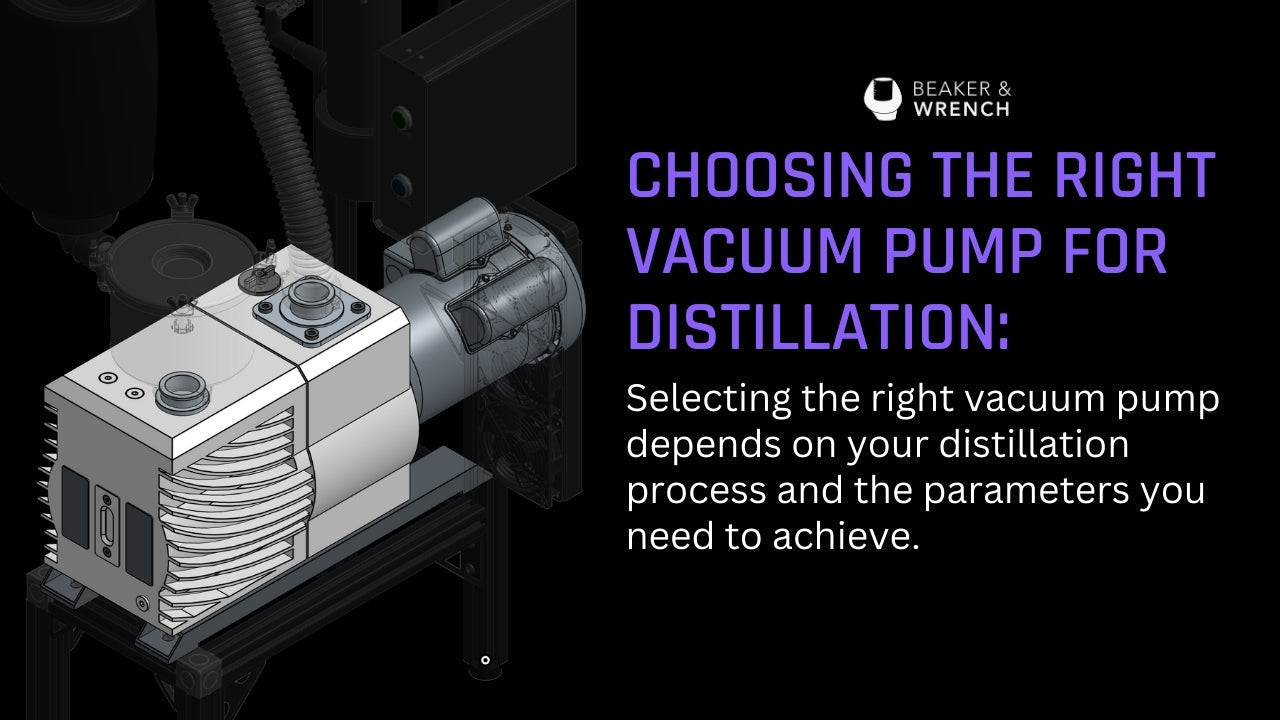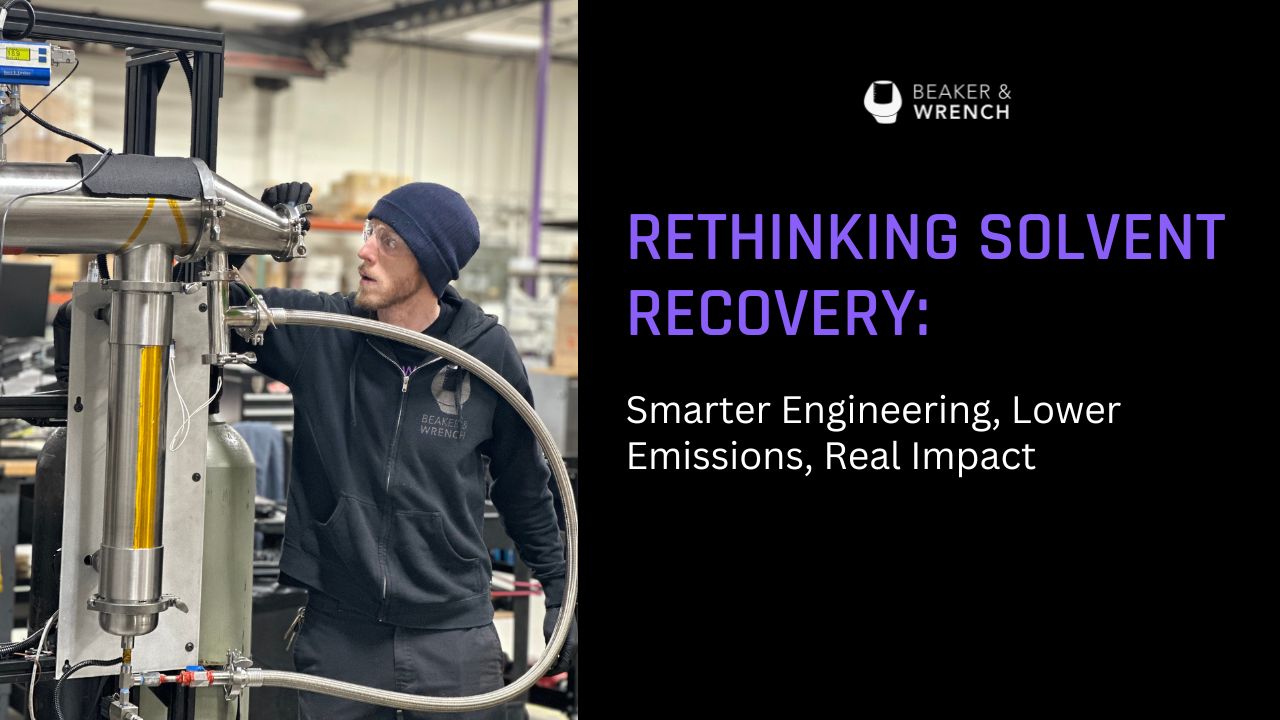Proper vacuum is something I constantly emphasize—because the right vacuum pump can make or break your entire process. When you focus on the quality of your vacuum, you’re able to reach the right depth, maintain efficiency, and cut down on downtime. Choosing the right pump depends on the nuances of your specific setup. In this blog, I’ll break down the different types of vacuum pumps and how they affect your distillation process.
Why Vacuum Pumps Matter in Distillation
What exactly does a vacuum pump do? Vacuum pumps create the low-pressure environment needed to reduce boiling points, allowing for separation of compounds at lower temperatures, which prevents thermal degradation. Without a reliable vacuum pump, achieving optimal yields and purity is a constant uphill battle. Vacuum pumps establish and maintain the vacuum, and remove air to prevent system contamination.
Vacuum Pumps directly affect the efficiency, speed, and quality of your distillation. A mismatched pump can lead to longer processing times, reduced yields, and increased maintenance costs. This is especially true when dealing with sensitive compounds that require precise control over environmental conditions.
Understanding Different Types of Vacuum Pumps
Each vacuum pump has its strengths and weaknesses, making them suitable for different applications. Understanding these differences is crucial for making an informed decision. Here are some of the most common types used in distillation.
Rotary Vane Pumps: The Workhorse
Rotary vane pumps are the workhorses of many distillation setups. These pumps are popular because they strike a balance between cost, performance, and vacuum depth. They can achieve very good vacuum levels, often reaching sub-micron levels, making them suitable for applications like wiped film distillation.
However, rotary vane pumps require regular maintenance. The oil needs frequent changes, especially if you’re dealing with solvent recovery, which can quickly contaminate the oil. On the plus side, these pumps are durable and long-lasting if properly maintained. For those looking for a reliable option without breaking the bank, rotary vane pumps are a solid choice.
Diaphragm Pumps: Handling Wet Systems
When dealing with solvent recovery or other “wet” processes, diaphragm pumps shine. These pumps are designed to handle condensable vapors and liquids without getting damaged. They may not achieve the same vacuum depth as rotary vane pumps, but they are incredibly reliable in harsh conditions. Diaphragm pumps can handle liquids without significant damage.
Diaphragm pumps are ideal for applications where the primary goal is to remove air and maintain a consistent vacuum rather than achieving ultra-low pressures. They are commonly used in solvent recovery systems where the condenser does most of the work, and the pump simply needs to keep the system running smoothly. Their robustness and low maintenance make them a practical choice for these demanding environments.
Diffusion Pumps: Achieving Deep Vacuum
For processes requiring extremely deep vacuum levels, diffusion pumps are the go-to option. These pumps can achieve vacuum levels several orders of magnitude lower than rotary vane pumps, making them suitable for specialized applications. In fact, the vacuum is so low it’s nearly a complete void.
Diffusion pumps operate differently than mechanical pumps. They use high-speed jets of vapor to move gas molecules, creating a vacuum. While they offer exceptional vacuum depth, they also have drawbacks, including poor performance above 10mTorr and long warm-up/cool-down times.
Turbo Pumps: The High-End Option
Turbo pumps represent the high-end of vacuum technology. They combine the advantages of diffusion pumps with greater convenience and control. Turbo pumps can achieve even deeper vacuum levels and offer faster start-up and shut-down times compared to diffusion pumps.
Turbo pumps are also more expensive and are necessary for distillation processes. However, if you need rapid start-up and shut-down, minimal maintenance, and extremely deep vacuum, turbo pumps are worth considering. For high-end applications where performance and convenience are paramount, turbo pumps deliver.
Dry Screw Pumps: Low Maintenance
Dry screw pumps are relatively new to the market and have minimal maintenance needs. These pumps don’t use oil, eliminating the need for frequent oil changes, and can handle comparatively large amounts of condensable vapor (second only to diaphragm pumps) . While they traditionally couldn’t reach the same vacuum depths as rotary vane pumps, newer models are closing the gap.
For operations where minimizing downtime and maintenance is crucial, dry screw pumps offer a compelling alternative. Although they come with a higher upfront cost and are less energy efficient, their ability to provide excellent performance in adverse conditions with low maintenance makes them a worthwhile investment
Scroll pumps
Dry scroll pumps are also known for their minimal maintenance needs. These pumps don’t use oil, eliminating the need for frequent oil changes, and are also the most energy efficient. While they can’t reach the same vacuum depths as rotary vane pumps, some models are capable of single-digit micron levels and pair well with turbo and diffusion pumps. Their ability to pump condensable vapors is often overstated. While there is no oil to contaminate, and they are rarely damaged, liquid can accumulate in the pump housing and lead to prolonged pump-down times and poor performance
With prices in between rotary vane and screw pumps and unmatched reliability the reduced pumping performance may well be worth the tradeoff
When you focus on the quality of your vacuum, you’re able to reach the right depth, maintain efficiency, and cut down on downtime.
Matching the Pump to Your Process
Selecting the right vacuum pump is not a one-size-fits-all decision. It depends on your specific distillation process and the parameters you need to achieve. Before choosing a pump, consider the following factors:
-
Vacuum Depth: How low of a pressure do you need to achieve? Different pumps have different capabilities.
-
Process Type: Are you dealing with a wet process like solvent recovery, or a dry(er) process like wiped film distillation?
-
Maintenance Requirements: How much time and effort are you willing to invest in maintaining the pump?
-
Cost: What is your budget for the pump and ongoing maintenance?
-
CFM (Cubic Feet per Minute): How much gas needs to be removed to maintain the desired vacuum level?
Wiped Film Distillation
Wiped film distillation requires deep vacuum levels to effectively separate compounds. For this application, rotary vane pumps are a common choice due to their ability to achieve sub-micron vacuum depths at a reasonable cost. To enhance performance, they are often paired with booster pumps like diffusion pumps.
The combination of a rotary vane pump and a diffusion pump offers a balance of cost and performance. However, if you’re looking for a lower maintenance option, a dry screw pump combined with a diffusion pump or turbo pump can be a good alternative, albeit at a higher cost. This setup provides deep vacuum levels with minimal upkeep.
Solvent Recovery
Solvent recovery systems require pumps that can handle wet, condensable vapors. Diaphragm pumps are well-suited for this application due to their ability to tolerate liquids without damage. These pumps don’t need to achieve ultra-low vacuum levels, so diaphragm pumps provide a reliable and cost-effective solution.
In solvent recovery, the condenser plays a crucial role in removing the bulk of the solvent vapors. The vacuum pump simply needs to maintain a consistent vacuum and remove any remaining air. Diaphragm pumps excel in this role, providing reliable performance with minimal maintenance. They’re also easy to use, making them ideal for solvent recovery.
Which Pump Is Right for You?
Every distillation setup is different, but most fall into a few common categories. Below are typical setups you might recognize—and the kind of vacuum pump that tends to work best:
-
You’re doing wiped film distillation and need a deep vacuum to preserve compound purity.
You’ll likely want a rotary vane pump paired with a booster pump like a diffusion or turbo pump to hit those sub-micron pressures. If you’re tired of oil changes, a dry screw pump combo could be a cleaner—but pricier—alternative.
-
You’re recovering solvents and dealing with lots of vapors.
A diaphragm pump is your friend. It’s designed to handle wet loads, requires minimal upkeep, and will keep your system running smoothly without solvent contamination issues. -
You’re scaling up and want to reduce downtime.
You might prioritize a low-maintenance dry screw pump to keep your operation lean and reduce the need for constant attention. -
You’re running a small R&D lab and need something cost-effective but reliable.
A rotary vane pump gives you strong performance at a reasonable cost—just stay on top of oil changes, especially with solvents in play.
Still not sure if your current pump is doing the job? Take a look at your run times, yields, and maintenance logs—they’ll often tell you if it’s time to upgrade or adjust. A well-matched pump is one of the most impactful investments you can make. Don’t underestimate the importance of choosing the right pump.
If you need help with your process, remember that we offer lab consultations at Beaker & Wrench. We can assist you in selecting the right equipment for your setup. Contact us at info@beakerandwrench.com to get started.



Leave a comment
All comments are moderated before being published.
This site is protected by hCaptcha and the hCaptcha Privacy Policy and Terms of Service apply.